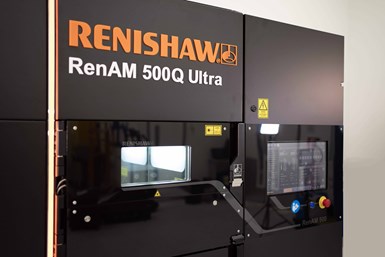Renishaw AM System Features Detailed Build Insight
The RenAM 500 Ultra system features innovative optical, chamber and gas-flow design, and also adds new productivity-boosting Tempus technology and advanced process monitoring software.
Share





Renishaw has expanded its RenAM 500 series of laser powder bed fusion (LPBF) systems with the launch of the RenAM 500 Ultra AM system, which can reportedly cut build times by up to 50% without compromising on quality, and give metal additive manufacturing (AM) users the tools to produce parts faster.
The RenAM 500 Ultra system includes all the existing benefits of the RenAM 500 series, including innovative optical, chamber and gas-flow design, and it adds new productivity-boosting Tempus technology and advanced process monitoring software.
Tempus technology incorporates new scanning algorithms that enable the laser to fire while the recoater is moving, saving up to nine seconds per build layer. The RenAM 500 Ultra’s advanced process monitoring software also delivers detailed insights into the build, equipping users with data and providing in-process visibility.
The RenAM 500 Ultra metal AM system is the latest model in the RenAM 500 family, which also includes the Flex system, optimized for R&D work, and the powder recirculation model for series production. The entire RenAM 500 family is available with one (500S) or four (500Q) high powered lasers, each able to access the whole powder bed simultaneously.
Related Content
-
The Benefits of Vertically Integrating Metal 3D Printing and Machining
Having 3D printing and machining within one organization enables Addman’s engineers to collaborate and consolidate so it can quickly make successful metal 3D printed parts.
-
Push-Button DED System Aims for Machine Shop Workflow in Metal Additive Manufacturing
Meltio M600 metal 3D printer employs probing, quick-change workholding and wire material stock to permit production in coordination with CNC machines.
-
Chuck Jaws Achieve 77% Weight Reduction Through 3D Printing
Alpha Precision Group (APG) has developed an innovative workholding design for faster spindle speeds through sinter-based additive manufacturing.



















.jpg;maxWidth=300;quality=90)


